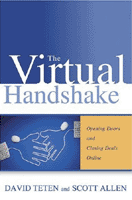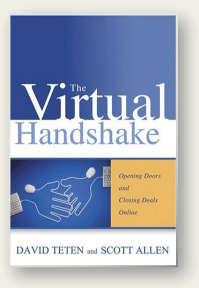Excellent guidebook for succeeding in the online world, including social networking
 The Virtual Handshake is an immensely valuable book, both as a handbook to the virtual world for the business-oriented person and as a guide to purposeful networking. I was compelled to get it after seeing David Teten speak at a conference because he spoke with authority while explaining new things clearly. Allen and Teten have done a masterful job at writing an interesting book that is full of useful information. Moreover, they succeed at providing a conceptual framework, so the reader can make use of the information. It is also a fun read.
The Virtual Handshake is an immensely valuable book, both as a handbook to the virtual world for the business-oriented person and as a guide to purposeful networking. I was compelled to get it after seeing David Teten speak at a conference because he spoke with authority while explaining new things clearly. Allen and Teten have done a masterful job at writing an interesting book that is full of useful information. Moreover, they succeed at providing a conceptual framework, so the reader can make use of the information. It is also a fun read.
As a marketing executive and a management consultant (strategy) since the early 1990s, I have helped to build parts of the virtual world the authors describe. I am very familiar with the topics, and I found the book useful on two key levels:
- Conceptual: The virtual world is difficult to understand conceptually because it is boundaryless and serendipitous, and the authors describe what it is enough so you can get to the point: how to interact with it to accomplish what you want. This is extremely important because the online world is limitless; one needs to understand enough of the content and potential to make actionable goals for oneself. The authors are very goal-oriented.
- Detail: The book contains several work strategies like how to work your email box and integrate it into your day so that you are not constantly interrupted; in addition, it includes myriad useful tips and information such as the latest sites to locate new emails for people with whom you’ve lost touch. As someone who spends extensive time on-line, I picked up numerous useful on-line resources, and the authors do a good job at pulling it all together into an actionable handbook.
Book Overview
Since the Table of Contents is not available on amazon.com, here is an overview along with brief comments:
Part One: Building Relationships Face to Face and Virtually
- Who Do You Know?
- The Seven Keys to a Powerful Network
- Face-to-Face Versus Virtual Communications
Everyone wants a better “network,” but what is a network exactly? Online tools are changing what is possible every month, and increasing people are online. Put these facts together, and they change what you can do, but most people don’t realize it and do not begin to appreciate the potential. Part One remedies this, and it also imparts the value of thinking strategically in terms of how you want your network to grow and how to make it happen. In Face-to-Face/Virtual, the book discusses the ramifications of having an on-line identity and how it differs from the offline identity. The bottom line: the authors conclude that the online identity can be harder to fake in the long-term because fakes are found out and exposed.
Part Two: Social Software
- Introduction to Social Software
- Building Your Virtual Presence
- E-mail Lists
- Relating in Real-Time
- Social Network Sites and Virtual Communities
- Blogs (Web Logs)
- Relationship Capital Management Software
- Software to Help You Meet Face to Face
- The Future of Social Software
Part Two is worth the price of the book by itself. Social networking (SN) is developing so quickly that most people (even in the technical field) are out of touch with what’s available and what they can do (and shouldn’t do). This substantial chapter will get you going quickly with less trial/error.
 Part Three: You Are the Virtual You
Part Three: You Are the Virtual You
- Netiquette
- Manage the E-Mail Deluge
- The Virtual You
- Privacy, Safety, and Other Concerns
Part Three offers numerous useful tips about interacting in SN spaces as well as email lists and others. Some people will find the email management techniques extremely useful. The privacy chapter has several practical tips to protect your privacy online as you seek to gain the right kind ,^) of exposure.
Part Four: The Seven Keys to a World-Class Network
- Improve Your Character
- Increase Your Competence
- Raise the Relevance of Your Network
- Build Strong Ties
- Increase the Quality and Quantity of Information
- Multiply the Number of People in Your Network
- Double Your Diversity
Part Four is dedicated to a concept to which the authors devote considerable energy, and they have a nifty formula for putting all the components together. More interesting, though, is the meaning of “character,” “competence” and “relevance” within the online, SN context.
Part Five: Turning Theory into Action: Online Networks in Your Job, Career and Life
- Ten Simple Steps to Radically Improve Your Network Online
- Finding a Job
- Marketing
- Sales
- Business Development
- Volunteering
- Afterword: How This Book Was Born
Part Five is full of “practical application” examples of the principles and strategies discussed in Parts One – Four. The chapters are short, but they discuss key concepts within the specific context of the chapter.
Appendices
- Appendix A: The Network Valuation Formula
- Appendix B: How to use This Book to Grow Your Network
Short notes that have hooks into the website (see below). The Network Valuation Formula is an approach to quantify—and therefore compare—network quality.
Etc.
- Glossary
- Endnotes
- Index
- Acknowledgements
- About the Authors
The index is good, but the endnotes are excellent. The authors cite 303 sources during the book, ranging from the esoteric (#158 “Netiquette for the Radio Control Soaring Exchange”) to the sublime (#150 “The Rolling Stones, ‘You Can’t Always Get What You Want'”). Fun and useful.
Website or Amazon.com
The authors deliver even more value here.
 Reflections
Reflections
It is precisely because we all live increasingly in virtual worlds that we need to network in the first place. Networks are self-organizing by default, which leads to limitless variety and opportunity. The problem is, since the Stone Age, humans have lived in relatively small communities with limited ability to meet new people. Moreover, the technology we have used and the way we have lived have also evolved slowly. In other words, our brains are not wired for the limitless potential of the online world.
When most people think of “networking,” they intend to meet people who could help them accomplish something they desire. Think back: even in the 1950s, this concept would border on the absurd for most people because they were not mobile; they knew their destiny, more of less, and they knew everyone they needed to know. Mobility and opportunity move together. In the 21st century context, however, networking correctly assumes that people are mobile and do not already know the people they need to know. It implies change and undiscovered opportunity. It is also a skill that very few people have natively. For example, studies of many cultures have consistently found that people can remember and keep track of about 150 other people, which coincides with the size of the largest hunter-gatherer bands.
Another more subtle benefit of the book is the attitude with which the authors write and their portrayal of online culture. They are very positive and straightforward in their approach, and they get across their purpose clearly. One cultural change in the online world to which offline people have to get accustomed is the concept of “loose ties.” After all, there is far more variety and choice online than off because the communication is electronic and digital; one does not have to move through space to contact or avoid other people. My hunch is that this lends a certain transactional and ephemeral nature to online relationships, which many sociologists term “loose ties.” With more choice comes speed, purpose (you’re not interacting unless you have a purpose) and mobility. Contrast online relationships with historical offline relationships: you happened to live next to that disagreeable crotchety person, and you had a relationship with that person as a function of physical proximity, not choice.
On a more practical note, the authors explicitly show how to translate qualities such as “integrity” and “character” to the online world, which is useful and interesting.
Highly recommended!

Leave a Reply
You must be logged in to post a comment.